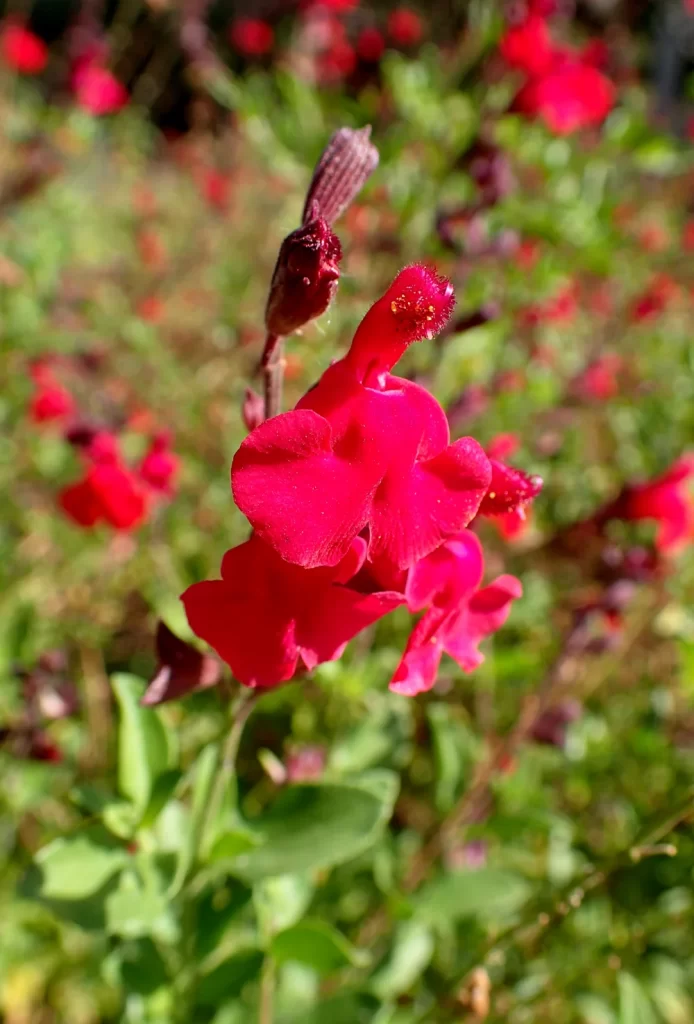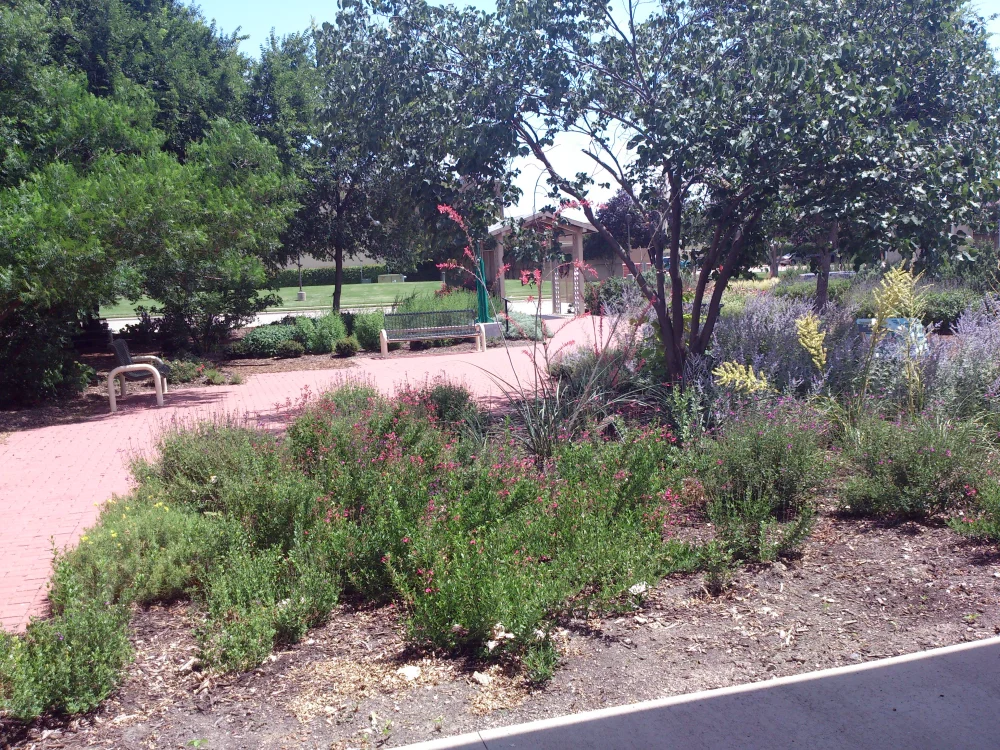By Barbara Kessler
Green Right Now
There’s been a lot of talk lately about energy independence. Important, no doubt. But we need to think about preserving water too, and nothing works harder toward this goal – or offers as much creative satisfaction – than xeriscaping.
Planting drought-resistant and native plants that survive on natural rainfall is a familiar concept in the desert Southwest and arid Colorado, where the term xeriscaping was coined to describe this approach to landscaping. This natural landscaping approach has spread to many areas where water conservation is an urgent issue, in most of Texas, Oklahoma and parts of California. Gardens with cacti, wildflowers, native grasses, Hill Country shrubs, and natural stones and rocks have been edging their way into areas previously manicured in the manner of English or European gardens.
In this endeavor, one could say that being green means dialing down the green in your lawn, giving up some of that solid sheet of thirsty turf and committing more area to a low-water garden that features rocks, flowering plants, shrubs and low-growing trees. That is xeriscaping, getting away from landscaping that drinks up too much precious water. (In Dallas, the water department estimates that 50 percent of the city’s drinking water is used to water lawns and gardens in the summer!)
But xeriscaping has been plagued by misconceptions. Some people picture it as necessarily desert-like, with cactus varieties as the main ingredient (no offense, cacti), or as an unwieldy profusion of native wildflowers or a collection of spiny plants amid a vast brown rug of gravel. None of this has to be the case. Xeriscape gardens can be tidy. They can be pruned. They can have cacti or not. If you think cacti don’t coordinate well with your hollies, leave them out, or try a yucca or aloe plant in a nearby bed with complementary perennial flowers. Gravel not, mulch will do. Or add a little pea gravel or river stone for interest, broken by turf that you’ve elected to keep.
To investigate the many facets of xeriscaping, we visited the Texas Discovery Gardens demonstration xeriscape garden in Dallas modeled after ideas by the late Texas A&M Professor Benny J. Simpson.
The forward-thinking Simpson searched for and studied Texas plants that might survive without extra irrigation in North Texas. He plucked many plants from the Big Bend area of the state, where the conditions are dry, but also where plants have to be fairly cold hardy, and tested them as landscape specimens. He introduced seven to nine unknown plants into commercial production “they were unknown in commercial nurseries – like this Texas sage and some of these salvias,” said Beverly Hayes, the director of horticulture for the Discovery Gardens, located at Fair Park in Dallas.
The problem Simpson faced was that when he found something that would survive, there was no guarantee that it would be accepted as a landscape plant. And if it was, people needed to understand that it should be planted in an area planned for drought-hardy plants, so it wouldn’t be over-watered.
For instance, the purple-flowering Texas sage that Mr. Simpson advocated found acceptance, but also withered, really drowned, in regularly watered gardens. Mesquite trees do the same. The Dallas demonstration garden thrives without watering (save some initial extra watering in the first year after planting) and without chemicals.
“Since we’re trying to attract butterflies and we want kids to come out to see bugs and how they interact with plants, if we sprayed chemicals we might kill some of them (the bugs that is, not the kids!),” said Ms. Hayes.
“We’re here to show off all kinds of nature, even the bugs that might chew holes in some of the plants.” So far, she said, no plant has been destroyed by bugs, giving credence to the organic gardening practice of letting good bugs and bad bugs duel it out.
The gardens also support the idea that native landscapes needn’t be messy or discordant. The recreated Simpson garden is a harmonious mix of small trees and shrubs with pockets of perennials nestled on a slope that’s been weeded and mulched. None of the plants appear untended.
A beautiful Mexican blue oak has been pruned from underneath to reveal multiple trunks and shape the plant into a small tree rather than the large unruly bush it would be in the wild. An agave has been given its own space to grow into a sturdy 10-year-old specimen plant.

Salvia greggii appear in discrete mounds in shades of pink and red, and are being cultivated in a deep purple in the Discovery Garden’s greenhouse. They will bloom from as early as February through November. Beat that with a heavier drinking annual.
Another flower, the brilliant yellow Damianita attests that colors in a xeriscape garden can be eye-popping.
True, a salt bush has consumed the base of a tree in another spot. And an Arizona Cedar has grown into a furry, uneven towering giant, but with bounteous needles. The look of this garden is not your garden variety landscaping. But then, beauty is in the eye of the beholder, and the beholder of such a garden will be holding a lower water bill.
If you’re interested in starting a xeriscape garden, here are the seven rules of xeriscaping put out by the Denver and Dallas water departments, as well as others:
1. PLAN. Know your soil type. Arrange for good drainage. Sketch out your garden for different water needs, for instance, some plants might need only rainfall, another section could require some hand watering.
2. TEST AND AMEND THE SOIL. To have your soil tested, check with your local county extension office, your local nursery or college horticulture department. In most cases, adding organic matter such as compost will enrich the soil and improve drainage and the soil’s ability to retain water. (Those last two concepts seem a bit at odds, but that’s part of the magic of compost and letting microorganisms thrive in your garden beds.)
3. ASSESS YOUR TURF NEEDS. Grass usually requires more water than any other part of your landscape. Use it if that’s what you need, for instance, for children to play on. But consider ground covers, shrubs and a patio for other areas. (Green alert: Concrete patios can be resource gobblers and create runoff. New, green concrete methods are evolving.)
4. USE APPROPRIATE PLANTS. Use native or drought-tolerant, adapted plants that can survive on the usual annual rainfall for your area. There are more to choose from than you realize.
5. WATER EFFICIENTLY. Watch to see when plants need water and then water them. Water deeply. This will help them root. Don’t water on a regular basis without regard to natural rainfall and/or the plants needs. You can kill drought-tolerant plants by over-watering. In fact, after the first year, the idea is that you don’t have to water them often, if at all. Water early in the morning to minimize evaporation under a hot sun. Water close to the ground with soaker hoses, misting or drip line sprinklers to curb water waste from sprinklers that cast water high in the air. Ask your local nursery about this, they probably water this way to keep their own water usage down.
6. GET ORGANIC MULCH. It conserves water and inhibits weeds. Some organic mulches include shredded cypress, pecan hulls, cotton seed hulls, composted leaves, shredded cedar and shredded landscape clippings.
7. MAINTAIN THE GARDEN. Xeriscape landscapes need less maintenance, but a tended yard is hardier and better able to withstand drought, freezing and pest problems. Prune trees and shrubs as needed. Remove diseased wood. Remove the dead buds or prune flowering perennial plants to stimulate blooms. Weed, but fertilize in moderation. Excessive fertilizer increases plants’ water needs and can be washed away by rain. Allow grass clippings to remain on the lawn as a natural fertilizer.
This story was originally posted April 19, 2007. It has been revised and updated.
